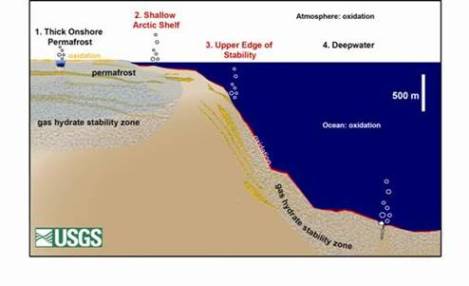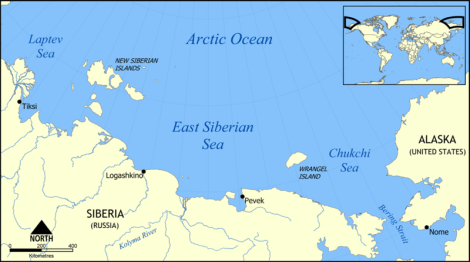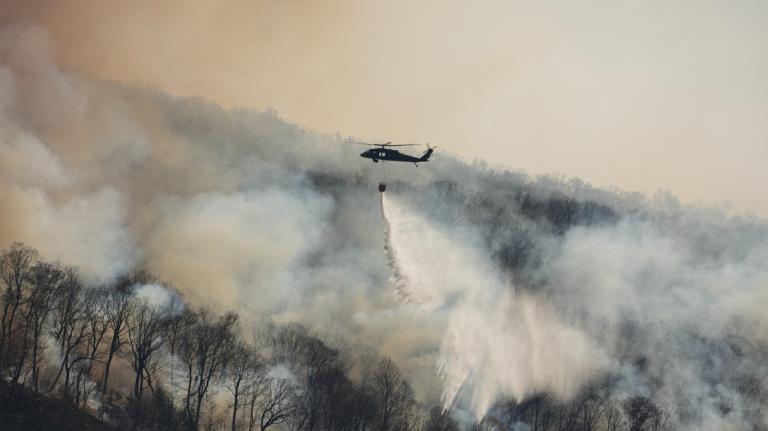 It was a stunning figure: $60 trillion.
It was a stunning figure: $60 trillion.
Such could be the cost, according to a recent commentary [PDF] in the journal Nature, of “the release of methane from thawing permafrost beneath the East Siberian Sea, off northern Russia … a figure comparable to the size of the world economy in 2012.” More specifically, the paper described a scenario in which rapid Arctic warming and sea ice retreat lead to a pulse of undersea methane being released into the atmosphere. How much methane? The paper modeled a release of 50 gigatons of this hard-hitting greenhouse gas (a gigaton is equal to a billion metric tons) between 2015 and 2025. This, in turn, would trigger still more warming and gargantuan damage and adaptation costs.
The $60 trillion figure went everywhere, and no wonder. It’s jaw-dropping. To provide some perspective, 50 gigatons is 10 times as much methane as currently exists in the atmosphere. Atmospheric methane levels have more than doubled since the industrial revolution, but this would amount to a much sharper increase in a dramatically shorter time frame.
According to the Nature commentary, that methane “is likely to be emitted as the seabed warms, either steadily over 50 years or suddenly.” Such are the scientific assumptions behind the paper’s economic analysis. But are those assumptions realistic — and could that much methane really be released suddenly from the Arctic?
A number of prominent scientists and methane experts interviewed for this article voiced strong skepticism about the Nature paper. “The scenario they used is so unlikely as to be completely pointless talking about,” says Gavin Schmidt, a noted climate researcher at the NASA Goddard Institute for Space Studies in New York.
Schmidt is hardly the only skeptic. “I don’t have any problem with 50 gigatons, but they’ve got the time scale all wrong,” adds David Archer, a geoscientist and expert on methane at the University of Chicago. “I would envision something like that coming out, you know, over the centuries.”
Still, the Nature paper is the most prominent airing yet of concerns that a climate catastrophe could be brought on by the release of Arctic methane that is currently frozen in subsea deposits — concerns that seem to be mounting in lockstep with the dramatic warming of the Arctic. That’s why it’s important to put these fears into context and try to determine just how much weight they ought to be accorded.
Methane on ice
Let’s start with some basics on methane — CH4 — a greenhouse gas that reaches the atmosphere from sources as diverse as wetlands, gas drilling, and cow burps. Compared with carbon dioxide, methane is kind of like the boxer who punches himself out in the early rounds, whereas carbon dioxide goes the distance and wins by TKO. Pound for pound, methane causes some 25 times as much global warming [PDF] as carbon dioxide does. But it only remains in the atmosphere for about nine years, on average, before chemical processes break it down. Carbon dioxide, in contrast, has a far longer atmospheric residence time.
What this means is that methane is most worrisome if a lot of it gets into the atmosphere over a relatively short time period — precisely the scenario contemplated by the Nature paper. So could that happen?
The answer depends on a complicated and uncertainty-laden issue — the stability of frozen deposits of subsea methane in the Arctic region. Frankly, it’s hard to imagine something harder to study: We’re talking about deposits residing not only beneath one of the world’s most remote and inaccessible oceans, but also beneath the sea floor itself.
Much of the world’s methane is concentrated in the form of so-called gas “hydrates,” icelike solids that form from methane and water at cold temperatures and high pressures, e.g., deep beneath the ocean floor. According to the U.S. Geological Survey, the total global carbon content of such methane hydrates is estimated to equal some 1,800 gigatons (to be sure, there is considerable uncertainty about this estimate).

U.S. Geological SurveyCross-section showing the location of methane hydrates, which are most vulnerable to dissolution in regions 2 and 3.
One thousand eight hundred gigatons would create a climate catastrophe if it were all to be suddenly released, but the vast majority of subsea methane is under deep water, and quite stable. Only a relatively small fraction of global methane hydrates are at issue in the Nature paper, and this methane is in a very peculiar situation: It is frozen in the subsea permafrost of relatively shallow continental shelves in the Arctic region. This frozen sediment was once coastline, but was submerged as oceans rose following the last Ice Age. And now, it is being bathed in warmer waters due to the warming of the Arctic.
So how much should we worry that these particular methane hydrates might melt, releasing gas that would then travel through both sediment and seawater to reach the atmosphere? That’s where the scientific debate begins — over both how much methane falls into this category, and how vulnerable it is to the warming that is now gripping the Arctic region.
Peering beneath the East Siberian Sea
The methane disaster concerns gained major prominence with a 2010 paper in Science by University of Alaska-Fairbanks researcher Natalia Shakhova and her colleagues, who examined methane emissions in a very remote area of the Arctic, the East Siberian Sea north of Russia. The continental shelf underlying this ocean is more than 2 million square kilometers (1.2 million square miles) in size, and its subsea permafrost lies only about 50 meters below the sea surface. Traveling to the remote region in Russian ice-breakers, Shakhova’s team sampled water content and air content at the sea surface repeatedly, over a series of years. They found high concentrations of methane in the water — “50 percent of surface waters are supersaturated with methane,” the paper reported — and some of the gas was also venting from the water into the atmosphere.
Although the Science paper did not contain the figure, it seems clear that Shakhova is the source for the idea that a 50-gigaton release of methane could occur in a short time frame. Or as she put it in a 2008 abstract [PDF], “[W]e consider release of up to 50 Gt of predicted amount of hydrate storage as highly possible for abrupt release at any time,” adding that this could lead to “catastrophic greenhouse warming.” The Nature paper cited another 2010 paper by Shakhova and her colleagues in the journal Doklady Earth Sciences, which uses the 50-gigaton figure in discussing possible methane emission scenarios.
Shakhova did not respond to several requests for comment for this article; her automatic email response said she was out doing fieldwork. But Peter Wadhams, the Cambridge physicist who is a coauthor of the Nature paper, said that his work relied on that of Shakhova and her team because “they’ve done the most work there, working there every year, doing field observations … we would rather base it on the estimates of the people actually working there, rather than the people who aren’t working there.” Here is a video of Shakhova discussing her research:
The trouble is that at this point, many other scientists don’t accept that work — or rather, don’t agree about its implications. None seem to dispute the actual measurements taken by Shakhova and her team, but as soon as the Science paper came out, a group of researchers questioned the idea that there was any cause for alarm. “A newly discovered [methane] source is not necessarily a changing source, much less a source that is changing in response to Arctic warming,” they wrote. The implication is that perhaps methane has always been in the water at such levels, without methane hydrates having been disturbed — rather, the methane may be from another source. According to one 2011 study, for instance, the observed methane probably came not from hydrates, but simply from “the permafrost’s still adjusting to its new aquatic conditions, even after 8,000 years.” The hydrates, in contrast, are thought to be much deeper below the sea surface, due to basic physical constraints on their formation and stability. According to the U.S. Geological Survey, “in permafrost areas, methane hydrate is not stable until about 225 m [738 feet] depth.”
Indeed, according to Ed Dlugokencky, who monitors global atmospheric methane levels at the National Oceanic and Atmospheric Administration, “so far, there has not been a significant increase in methane emissions in the Arctic.” In other words, if methane is really starting to vent into the air in large quantities, Dlugokencky says he isn’t seeing it.
A debate over hydrate depth
And that’s just the first reason that many scientists are skeptical. According to Carolyn Ruppel, who heads the Gas Hydrates Project at the U.S. Geological Survey, there just isn’t that much vulnerable methane in submerged permafrost to begin with. “We think very little hydrate on this planet is associated with permafrost, either subsea or terrestrial,” she says. Inspired in part by the Shakhova research, the USGS undertook to study the continental shelves of the Beaufort Sea, off Alaska and Canada. “We set out to test this idea that all of the Arctic shelves were going to have high methane emissions,” she says. “And at least for the U.S. Beaufort shelf, we’re not seeing them.”
Ruppel acknowledges that due to Arctic warming, more methane is going to be released, much of it from permafrost on land. But, she continues, “I would say one of the least likely sources is methane gas hydrates. You are limited by the laws of physics,” she adds — noting that the beginning of the zone of stability for these hydrates is some 220 meters (722 feet) deep. That’s a recurrent refrain among skeptics — they say hydrates just can’t form above a certain depth, and warming can’t penetrate such a depth very quickly. “You’ve got to go from the sea floor of 50 meters depth, down to 200 meters where the hydrate is,” explains the University of Chicago’s David Archer. “So that just takes a long time.”
Moreover, even if subsea permafrost methane hydrates do thaw, the liberated gas still has to travel through layers of sediment just to get to the ocean floor. So how does that happen? “That’s kind of mysterious,” says Archer. Perhaps there will be open pathways for gas in some places, but perhaps there won’t. Archer also notes that there have been undersea explosions or landslides that release methane in bursts, but “those kinds of things seem like they would be relatively small compared to 50 gigatons, and they would happen sporadically in time over centuries; not everything blows up in a few years.”
Nonetheless, imagine that methane gas from melted hydrate makes it to the sea floor. It now exists as bubbles with, say, 50 meters (164 feet) to go before they reach the sea surface. Most of the bubbles won’t make it, say scientists: They’ll be dissolved in seawater, and then the methane will be broken down by microorganisms over a period of months. “If methane is in the ocean water column, most of it doesn’t get out,” explains Bill Reeburgh, a professor of earth system science at the University of California-Irvine who has spent his career studying methane. “Most of it is oxidized” by bacteria, which turn it into carbon dioxide and water, Reeburgh continues. “So all these stories about seeps, people seem to think the bubbles go straight to the atmosphere, and they don’t.”
In other words, while the waters of the East Siberian Sea may be full of dissolved methane, for many scientists that doesn’t prove that hydrates have been disturbed, or that the Arctic is starting to vent large amounts of methane from below the sea floor into the atmosphere. Not yet, anyway.
Nonetheless, Cambridge’s Peter Wadhams takes a different view. Of the critics, he says that “it comes to not believing that these scientists who are actually working there know what they’re talking about, which I would say is kind of insulting to them.” Wadhams also says that there is a new mechanism for methane hydrate release that the critics aren’t considering. The retreat of Arctic sea ice, he suggests, is allowing very intense warming of the waters above continental shelves. He adds that there are certain hydrates “detectable at 20 meters [66 feet]” below the sea floor, far shallower than normal. Wadhams calls these hydrates “Ice Age relics” that formed under very different conditions. Shakhova, too, has referred in the past to hydrates occurring at 20 meters depth, saying they have been “sampled in Siberia.”
Other scientists remain skeptical. David Archer says his simulations “never see hydrate stability” above 250 meters (820 feet).
So should you worry?
What is clear about this story, then, is that one group of scientists has articulated a set of concerns that a number of others just do not accept at this point. And no doubt this problem is exacerbated by the realities of methane hydrate research — it is extremely difficult (and costly) to take a scientific expedition to the East Siberian Sea, or for that matter, to conduct Arctic research in general. In this case, it appears that one research team, the one actually working in this area, has developed views distant from those of many other researchers.
So what should you do — and what should you think? Bear in mind that there are many good reasons to be skeptical of a methane disaster — it is hardly a matter of scientific consensus that this is a real concern. And that stands in stark contrast to the issue of climate change in general, an issue on which scientists are overwhelmingly aligned (and where the solution remains incredibly obvious: cutting carbon emissions).
As global warming proceeds, it is also important to step back and acknowledge that with the unprecedented warming of the Arctic, it would be surprising if there weren’t surprises. When we bring on warming this fast, we risk unpredictable consequences, whether with regard to methane or something else.
“It’s weird for me to be saying, ‘Oh, it could never happen.’ It’s always the wrong side of things when you’re talking about nature,” says David Archer of the Arctic methane catastrophe scenario. “But,” he adds, “nobody’s come up with a defendable way of it happening all at once.”
 This story was produced by Mother Jones as part of the Climate Desk collaboration.
This story was produced by Mother Jones as part of the Climate Desk collaboration.




